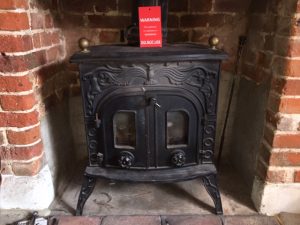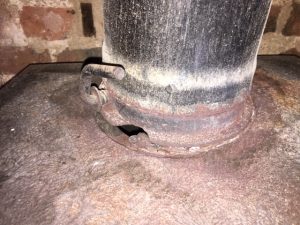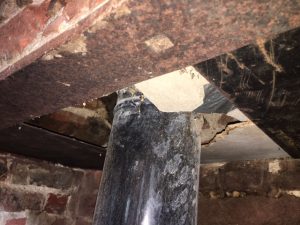 Only yesterday a customer in Weston Colville called me to say that she had a live bird stuck in her chimney that she wanted removing; if possible alive. I was in the fortunate position yesterday that I was able to attend her address immediately and removed the said bird without it being caused to much harm; well other than the stress of being stuck down a chimney for a couple of hours!
Only yesterday a customer in Weston Colville called me to say that she had a live bird stuck in her chimney that she wanted removing; if possible alive. I was in the fortunate position yesterday that I was able to attend her address immediately and removed the said bird without it being caused to much harm; well other than the stress of being stuck down a chimney for a couple of hours!
The bird, most probably a pigeon, seemed to be located about half the way down the flue liner; the chimney being quite short only about seven and a half meters tall. I therefore decided to gently push the bird up the chimney and out the chimney pot using my large viper and a liner brush (150mm). This was a most effective way of removing the bird from the flue without harming it. Bit by bit, I gently edged it up the liner until it was able to fly clear of the chimney pot. A job well done if I say so myself.
Prior to undertaking this removal, I had taken the precautions of spreading dust sheeting around the room, closing all the doors and opening all the windows. The customer had told me that the chimney had not been swept for at least three years, and potentially longer. So, I was cognizant of the fact that the chimney would be very dirty and consequently the bird would be very dirty and could create quite a bit of mess should it get out of the stove into the room. So, every precaution was taken to prevent this happening and to minimize any mess should it happen.

Whilst working to remove the bird from the chimney my attention had been drawn to the condition of the customers stove and installation. The customer had told me that the stove had been in place for at least 27 years and that the anti-bird cowl that had once sat on top of the chimney pot had been missing for quite some time. I could not identify the make or model of the stove, but it had the appearance of an inexpensive Chinese make. I noticed that the top of the stove, in particular the joint between stove and stove pipe was badly corroded; to the point that there was a significant hole at this junction. Presumably rain water had for some time been coming down the chimney because of the missing anti-bird cowl. To compound these problems the register plate had completely failed around the area of the stove pipe. Here, the register plate had been fabricated using flame-board, whereas at the sides it was steel. At some stage the flame-board had become cracked and pieces had simply dropped out (See Photographs). Further to all this, many of the internal components of the stove had failed and were broken, making its efficient operation impossible.
It was clear to me that the stove was no longer in a safe condition to use and presented a significant danger to the customer, particularly in terms of Carbon Monoxide poisoning. Although the customer did have a working Carbon Monoxide alarm, it was positioned quite some distance from the appliance and behind a bookcase. Building Regulations (Document J) states that the Carbon Monoxide alarm should be located between 1 to 3 meters from the appliance whereas the customers was about 6 meters from the appliance. Clearly, I had no option but to officially condemn the stove as it was not safe to use.

This is all very well, but it then creates the problem of breaking bad news to the customer; and how best to go about ameliorating their disappointment. Interestingly, it was only in the last few weeks that the Guild of Master Sweeps issued guidance to sweeps on how best to go about diplomatically imparting such information to customers. I went about it in the most sympathetic and empathetic way possible, pointing out the dangers the appliance presented whilst emphasizing the years of trouble-free use and pleasure the customer had had from the stove. I additionally supported her in suggesting local companies who could present her with the options for a replacement stove installation. I then fully documented the work I had done, the safety issues and photographed the appliance (copies were then supplied to the customer, who seemed to be more than satisfied with the service I had given her on the day.
Tune in next weekend for a further update on the progress of the puppies!


 My name is Paddy McKeown, I am a retired police officer (Detective Sergeant – Metropolitan Police), turned chimney sweep. I have completed training with ‘The Guild of Master Chimney Sweeps’, and Rod Tech UK (Power Sweeping).
My name is Paddy McKeown, I am a retired police officer (Detective Sergeant – Metropolitan Police), turned chimney sweep. I have completed training with ‘The Guild of Master Chimney Sweeps’, and Rod Tech UK (Power Sweeping).




Comments are closed.